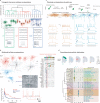A community-based transcriptomics classification and nomenclature of neocortical cell types
- PMID: 32839617
- PMCID: PMC7683348
- DOI: 10.1038/s41593-020-0685-8
A community-based transcriptomics classification and nomenclature of neocortical cell types
Erratum in
-
Publisher Correction: A community-based transcriptomics classification and nomenclature of neocortical cell types.Nat Neurosci. 2021 Apr;24(4):613. doi: 10.1038/s41593-020-00768-3. Nat Neurosci. 2021. PMID: 33277642 Free PMC article. No abstract available.
-
Author Correction: A community-based transcriptomics classification and nomenclature of neocortical cell types.Nat Neurosci. 2021 Apr;24(4):612. doi: 10.1038/s41593-020-00779-0. Nat Neurosci. 2021. PMID: 33742182 Free PMC article. No abstract available.
Abstract
To understand the function of cortical circuits, it is necessary to catalog their cellular diversity. Past attempts to do so using anatomical, physiological or molecular features of cortical cells have not resulted in a unified taxonomy of neuronal or glial cell types, partly due to limited data. Single-cell transcriptomics is enabling, for the first time, systematic high-throughput measurements of cortical cells and generation of datasets that hold the promise of being complete, accurate and permanent. Statistical analyses of these data reveal clusters that often correspond to cell types previously defined by morphological or physiological criteria and that appear conserved across cortical areas and species. To capitalize on these new methods, we propose the adoption of a transcriptome-based taxonomy of cell types for mammalian neocortex. This classification should be hierarchical and use a standardized nomenclature. It should be based on a probabilistic definition of a cell type and incorporate data from different approaches, developmental stages and species. A community-based classification and data aggregation model, such as a knowledge graph, could provide a common foundation for the study of cortical circuits. This community-based classification, nomenclature and data aggregation could serve as an example for cell type atlases in other parts of the body.
Conflict of interest statement
The authors declare no competing interests.
Figures





References
-
- Magner, L.N. A History of the Life Sciences (Marcel Dekker, 1979).
-
- Ramón y Cajal S. Rev Ciencias Méd. Barcelona. 1892;18:361–376.
-
- Ramón y Cajal, S. Recuerdos de Mi Vida: Vol.2. Historia de Mi Labor Científica (Imprenta y librería de Nicolás Moya, 1917).
-
- Ramón y Cajal, S. La Textura del Sistema Nerviosa del Hombre y los Vertebrados (Imprenta y librería de Nicolás Moya, 1904).
-
- Hubel DH, Wiesel TN. Proc. R. Soc. Lond. B Biol. Sci. 1977;198:1–59. - PubMed
Publication types
MeSH terms
Grants and funding
LinkOut - more resources
Full Text Sources
Miscellaneous

